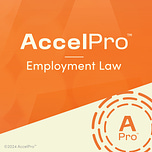Welcome to AccelPro Employment Law, where we provide expert interviews and coaching to accelerate your professional development. Today we’re featuring a conversation about worker classification. Our guest is Beth Milito. She’s the Executive Director of the National Federation of Independent Business’s (NFIB) Small Business Legal Center.
It sounds simple: You’re an employee, or you’re not. But the truth is, determining who should be an employee and who should be an independent contractor is exceedingly difficult, especially considering the standards for making that decision vary from state to state, and sometimes even within each state.
In this interview, Milito describes the challenges small businesses face in deciding whether to classify workers as independent contractors, examines best practices in how to make those decisions and explains the consequences of misclassifying workers as independent contractors when they should be employees.
AccelPro’s expert interviews and coaching accelerate your professional development. Join AccelPro Employment Law now for a free trial of everything we offer to members.
Interview References:
Beth Milito’s LinkedIn profile and 2022 NFIB promotion announcement
3:40 | Milito, Elizabeth. (December 10, 2022). [Letter from Elizabeth Milito to Honorable Martin J. Walsh, US. Secretary of Labor]. Department of Labor Wage and Hour Division Notice of Proposed Rulemaking Titled “Employee or Independent Contractor Classification Under the Fair Labor Standards Act,” RIN1235-AA43, 87 Fed. Reg. 62218 (October 13, 2022).
7:35 | Independent Contractor (Self-Employed) or Employee?. International Revenue Service.
7:40 | NFIB Guide to Independent Contractors: How to Determine a Worker’s Classification. NFIB Small Business Legal Center.
12:07 | California AB-5 Worker status: employees and independent contractors. Assembly Bill No. 5, Chapter 296 (2019).
Supplemental Materials:
National Federation of Independent Business. (October 11, 2022). NFIB Opposes DOL Proposed Rule on Independent Contractors.
TRANSCRIPT
I. THE CHALLENGES OF CLASSIFYING WORKERS
Matt Crossman, Host: You are the Executive Director of the NFIB’s Small Business Legal Center. What does the National Federation of Independent Businesses do?
Beth Milito: The NFIB represents about 300,000 small and independent businesses across the country. We have members in every state and every industry. The NFIB, which is an advocacy organization, helps small businesses own, operate and grow their businesses. We lobby in state capitals and Congress, and we are also in the courts, and that is my role as the Executive Director of the Small Business Legal Center.
I try to bring the voice of small businesses to the nation’s federal and state courts. A big part of my job in the Legal Center is helping small business owners with compliance issues, whether it’s human resources, taxes or contracts.
MC: We’re going to dig deep on one of those issues in particular, worker classification. I imagine this issue comes up a lot with your membership. What is the most common question you get regarding worker classification?
BM: It’s a tough area. And as we have seen growth in independent workers over the last three years since the pandemic, the questions are coming more frequently from business owners who hire independent contractors or subcontractors.
So when is a worker an employee versus a 1099 independent contractor? You want to make sure as a business that you get it right. Misclassifying workers can be a very expensive mistake.
MC: In your role as the executive director of the NFIB’s Small Business Legal Center, you wrote a letter to Martin Walsh, then the United States Secretary of Labor, and you summed up the challenges small businesses face in dealing with worker classification very well.
You wrote, “The challenge is particularly acute for small business owners who must generally determine worker status without the benefit of outside legal counsel or even in-house human resource expertise. A small business owner’s final determination on worker status can be a risky endeavor with abundant penalties for unintentional mistakes.”
Not to put too fine a point on it, but a small business’s very survival could hinge on this. What advice do you have for small business owners and HR execs when they’re deciding their staffing models?
BM: Great question, and there’s a lot in that, so let me unpack it a little bit. The challenge of determining the classification of a worker is made difficult, frankly, because there are different federal and state tests, and some states have multiple tests. But to simplify it, let’s just say that at the center of all the tests is a question of who has the right to control how the work is performed. If the company has the right to control the manner and means of how the work is performed, then the worker is an employee.
Misclassifying a worker can be costly. Why is that? First of all, with independent contractors, you don’t withhold payroll taxes. So what happens when you don’t pay your taxes? Not only do you have to pay the back taxes, but usually there is a fine associated with non-payment of taxes.
So if you don’t withhold and pay those payroll taxes, because you’ve misclassified a worker as an independent contractor, odds are the IRS and the state revenue agency are going to come back and say, “You misclassified these five workers here, so now you owe back payroll taxes. And by the way, there is a penalty associated with not paying those taxes.”
So that’s expensive, right? Because you’re paying a penalty on top of back taxes, too. The other issue that comes up then is a worker might come in and say, “I was misclassified as an independent contractor. I really was an employee. Not only do you need to pay all those payroll taxes that you didn’t withhold, but I was also working overtime. So you also owe me unpaid overtime.”
So all this is to say that misclassifying a worker as an independent contractor can be a very costly mistake. That’s why businesses want to try to get it right, and we can talk about some things a business can do to make sure they are classifying workers correctly.
If you have misclassified somebody, I always like to say you need to quietly get into compliance. Don’t be afraid to fix a mistake.
—
II. THE HOW-TOS OF CLASSIFYING WORKERS
MC: You just said we can talk about what businesses can do to make sure they’re in compliance. If that’s not the most important subject for us to talk about, I’m not sure what is. It is so confusing and so complicated. What advice do you have for HR executives and attorneys to make sure they comply?
Listen to this episode with a 7-day free trial
Subscribe to AccelPro | Employment & Labor Law to listen to this post and get 7 days of free access to the full post archives.












